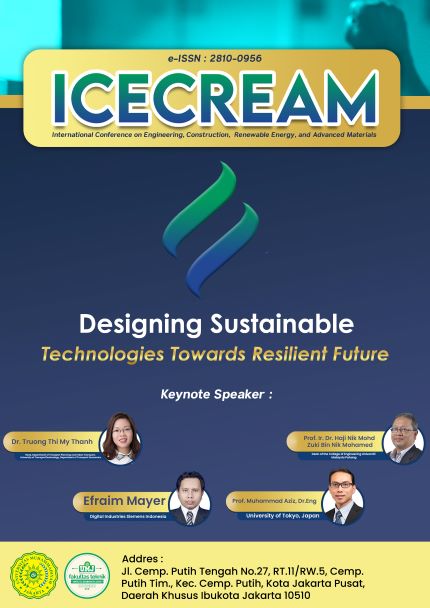Characteristics of Edible Film from Rice Bran Starch as Affected by the Concentration of Sorbitol Plasticizer
Abstract
Edible films made from starch have disadvantages, namely they are brittle so they are easily broken and hydrophilic. The manufacture of starch-based edible films basically uses the principle of gelatinization. The purpose of this study was to make edible film from rice bran, and to examine the effect of concentration of plasticizer (sorbitol) and gelatinization time on the characteristics of the edible film. The process chosen in this study is Steam Boiler with the advantage that it can optimize the gelatinization of rice bran starch and takes 22 minutes at a temperature of 65°C - 70ºC. The percentage of solubility of edible films ranges from 48 – 75%. The results of the analysis of the variance of the treatment effect on the solubility level of the edible film at 6 hours of immersion showed that the treatment concentrations of 3%, 4% and 5% had no significant effect on the percentage of the solubility of the edible films. Meanwhile, the 6% and 7% sorbitol concentrations had a greater effect than the 3%, 4% and 5% concentrations. The results of the biodegradability test showed that the biodegradable film from rice bran starch treated with the concentration of sorbitol that was stockpiled in the soil could be degraded after stockpiling in the soil for 18 days, which was marked by damage to the biodegradable film sheet. Edible film with 3% sorbitol concentration has the lowest water vapor transmission rate compared to other edible films, which is -0.27 %. The highest water vapor transmission rate was found in edible film with 6% sorbitol concentration.References
S. R. Dewi Et Al., “Seminar Nasional Penelitian Lppm Umj Website: Http://Jurnal.Umj.Ac.Id/Index.Php/Semnaslit E-Pembuatan Dan Karakterisasi Kelarutan Dalam Air Dan Biodegradibilitas Bioplastik Dari Campuran Dedak Padi-Jagung.” [Online]. Available: Http://Jurnal.Umj.Ac.Id/Index.Php/Semnaslit
S. Rawdkuen, “Rice Bran: A Potential Of Main Ingredient In Healthy Beverage,” 2016. [Online]. Available: Https://Www.Researchgate.Net/Publication/311844255
R. Baskara, K. Anandito, E. Nurhartadi, And A. Bukhori, “Pengaruh Gliserol Terhadap Karakteristik Edible Film Berbahan Dasar Tepung Jali (Coix Lacryma-Jobi L.) Effect Of Glycerol On The Characteristics Of Edible Film From Jali (Coix Lacryma-Jobi L.) Flour,” 2012.
A. M. Jacoeb, R. Nugraha, S. P. Sri, And D. Utari, “Edible Film From Lindur Fruit Starch With Addition Of Glycerol And Carrageenan.”
C. Fabian, A. Ayucitra, S. Ismadji, And Y. H. Ju, “Isolation And Characterization Of Starch From Defatted Rice Bran,” J Taiwan Inst Chem Eng, Vol. 42, No. 1, Pp. 86–91, Jan. 2011, Doi: 10.1016/J.Jtice.2010.03.013.
B. Rahardjo, D. Wiseso Marseno, And J. Nugroho Wahyu Karyadi, “Sifat Fisik, Mekanik Dan Barrier Edible Film Berbasis Pati Umbi Kimpul (Xanthosoma Sagittifolium) Yang Diinkorporasi Dengan Kalium Sorbat Physical, Mechanical And Barrier Properties Of Xanthosoma Sagittifolium Starch-Based Edible Film Incorporated With Potassium Sorbate,” 2014.
M. K. Marichelvam, M. Jawaid, And M. Asim, “Corn And Rice Starch-Based Bio-Plastics As Alternative Packaging Materials,” Fibers, Vol. 7, No. 4, Apr. 2019, Doi: 10.3390/Fib7040032.
C. Fabian, A. Ayucitra, S. Ismadji, And Y. H. Ju, “Isolation And Characterization Of Starch From Defatted Rice Bran,” J Taiwan Inst Chem Eng, Vol. 42, No. 1, Pp. 86–91, Jan. 2011, Doi: 10.1016/J.Jtice.2010.03.013.
F. Sari, R. Ariatmi Nugrahani, A. Sri Redjeki, And T. Yuni Hendrawati, “Prosiding Seminar Nasional Pengabdian Masyarakat Lppm Umj Website: Http://Jurnal.Umj.Ac.Id/Index.Php/Semnaskat E-Issn: 2714-6286.” [Online]. Available: Http://Www.Nutritionfoundationofindia.Res.In
U. H. Habibah, “Pengaruh Konsentrasi Asam Sulfat Pada Proses Hidrolisis Dedak Padi Menjadi Glukosa Untuk Pembuatan Plastik Biodegradabel,” 2018.
“Pemanfaatan Pati Singkong Sebagai Bahan Baku Edible Film. Sub-Tema Daya Saing, Keunggulan Dan Penguasaan Ipteks - Pdf Free Download”.
J. Krotcha, Edible Coatings And Films To Improve Food Quality. Technomic Publishing Company., 1994.
C. Guo And H. Guo, “Progress In The Degradability Of Biodegradable Film Materials For Packaging,” Membranes, Vol. 12, No. 5. Mdpi, May 01, 2022. Doi: 10.3390/Membranes12050500.

